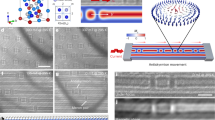Abstract
Double-slit electron interferometers fabricated in high mobility two-dimensional electron gases are powerful tools for studying coherent wave-like phenomena in mesoscopic systems1,2,3,4,5,6. However, they suffer from low visibility of the interference patterns due to the many channels present in each slit, and from poor sensitivity to small currents due to their open geometry3,4,5,7. Moreover, these interferometers do not function in high magnetic fields—such as those required to enter the quantum Hall effect regime8—as the field destroys the symmetry between left and right slits. Here we report the fabrication and operation of a single-channel, two-path electron interferometer that functions in a high magnetic field. This device is the first electronic analogue of the optical Mach–Zehnder interferometer9, and opens the way to measuring interference of quasiparticles with fractional charges. On the basis of measurements of single edge state and closed geometry transport in the quantum Hall effect regime, we find that the interferometer is highly sensitive and exhibits very high visibility (62%). However, the interference pattern decays precipitously with increasing electron temperature or energy. Although the origin of this dephasing is unclear, we show, via shot-noise measurements, that it is not a decoherence process that results from inelastic scattering events.
This is a preview of subscription content, access via your institution
Access options
Subscribe to this journal
Receive 51 print issues and online access
$199.00 per year
only $3.90 per issue
Buy this article
- Purchase on Springer Link
- Instant access to full article PDF
Prices may be subject to local taxes which are calculated during checkout




Similar content being viewed by others
References
Yacoby, A., Heiblum, M., Umansky, V., Shtrikman, H. & Mahalu, D. Unexpected periodicity in an electronic double slit interference experiment. Phys. Rev. Lett. 73, 3149–3152 (1994)
Yacoby, A., Heiblum, M., Mahalu, D. & Shtrikman, H. Coherency and phase sensitive measurements in a quantum dot. Phys. Rev. Lett. 74, 4047–4050 (1994)
Schuster, R. et al. Phase measurement in a quantum dot via a double-slit interference measurement. Nature 385, 417–420 (1997)
Ji, Y., Heiblum, M., Sprinzak, D., Mahalu, D. & Shtrikman, H. Phase evolution in a Kondo-correlated system. Science 290, 779–783 (2000)
Buks, E., Schuster, R., Heiblum, M., Mahalu, D. & Shtrikman, H. Dephasing in electron interference by a ‘which-path’ detector. Nature 391, 871–820 (1998)
van der Viel, W. G. et al. The Kondo effect at unitary limit. Science 289, 2105–2108 (2000)
Buttiker, M. Four terminal phase coherent conductance. Phys. Rev. Lett. 57, 1761–1764 (1986)
Prange, R. E. & Girvin, S. M. (eds) The Quantum Hall Effect (Springer, New York, 1987)
Born, M. & Wolf, E. Principles of Optics 348–352, 7th edn (Cambridge Univ. Press, Cambridge, UK, 1999)
Aharonov, Y. & Bohm, D. Significance of electromagnetic potentials in the quantum theory. Phys. Rev. 115, 485–491 (1959)
Aronov, A. G. & Sharvin, Yu. V. Magnetic flux effects in disordered conductors. Rev. Mod. Phys. 59, 755–779 (1987)
de-Picciotto, R. et al. Direct observation of a fractional charge. Nature 389, 162–165 (1997)
Reznikov, M. et al. Quantum shot noise. Superlattice Microstruct. 23, 901–915 (1998)
Chklovskii, D. B., Shklovskii, B. I. & Glazman, L. I. Electrostatics of edge channels. Phys. Rev. B 46, 4026–4034 (1992)
Kane, C. L. Telegraph noise and fractional statistics in the quantum Hall effect. Preprint cond-mat/0210621 at 〈http://xxx.lanl.gov〉 (2002).
Acknowledgements
We thank Y. Levinson for clarifying the issue of phase averaging, and C. Kane for comments on the manuscript. The work was partly supported by the MINERVA Foundation, the Israeli Academy of Science, the German Israeli Project Cooperation (DIP), the German Israeli Foundation (GIF), and the EU QUACS network.
Author information
Authors and Affiliations
Corresponding author
Ethics declarations
Competing interests
The authors declare that they have no competing financial interests.
Rights and permissions
About this article
Cite this article
Ji, Y., Chung, Y., Sprinzak, D. et al. An electronic Mach–Zehnder interferometer. Nature 422, 415–418 (2003). https://doi.org/10.1038/nature01503
Received:
Accepted:
Issue Date:
DOI: https://doi.org/10.1038/nature01503
This article is cited by
-
Quasi-one-dimensional transport in graphene under a magnetic field
Journal of the Korean Physical Society (2024)
-
Observation of electronic modes in open cavity resonator
Nature Communications (2023)
-
Anyonic interference and braiding phase in a Mach-Zehnder interferometer
Nature Physics (2023)
-
Electro-static properties of GaAs based two-dimensional bilayer systems
Indian Journal of Physics (2023)
-
Topological current divider in a Chern insulator junction
Nature Communications (2022)
Comments
By submitting a comment you agree to abide by our Terms and Community Guidelines. If you find something abusive or that does not comply with our terms or guidelines please flag it as inappropriate.



